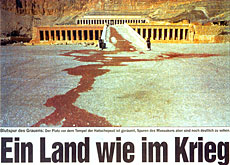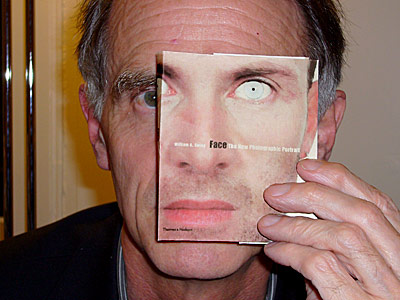Seeing isn’t believing

They say the camera never lies, but an exhibition in Bern's Museum of Communication shows that images can certainly be economical with the truth.
The exhibition features more than 300 photos that have been tampered with in some way, and reveals just how it was done – and why.
Some examples will be uncomfortably familiar to Swiss visitors.
One, which made headlines in 1997, was the pool of blood outside the Temple of Hatsheput in Egypt, after the Luxor massacre in which 62 people died – 36 of them Swiss. The harrowing photo was published independently by the Swiss mass-circulation newspaper Blick and by Swiss television.
But… it wasn’t blood at all. The picture had been doctored: the water in an ordinary puddle had been coloured red.
The change was quickly uncovered and both media were forced to apologise.
“Sometimes these are just amusing examples that puzzle you, and that you can laugh about,” said Ulrich Schenk, exhibition curator. “But doctored photos can also damage or destroy people.”
Another notorious recent case in Switzerland also concerned the tabloid press, which in 2002 printed faked photos of the then Swiss ambassador to Berlin, Thomas Borer, suggesting he was having an affair.
In this case too the tampering was soon revealed, but it was too late for Borer: the non-existent scandal cost him his job.
Fooling the people
The Luxor pool and the Borer affair are just two of the examples featured in the touring exhibition “Bilder, die lügen” (Images that Lie).
“The point is to make visitors aware of the need to examine pictures carefully, and to ask themselves about the interests that might lie behind them,” Schenk explained.
The exhibition has attracted a lot of attention.
“The response has been very good, and it is interesting to see that people really do feel the need to invest time in looking,” he commented.
The exhibition contains numerous pictures from the Soviet Union. As Soviet leader Joseph Stalin stepped up his repression, he had more and more people removed from historical photos because they had fallen into disfavour.
So have photos and fakery gone hand in hand from the very beginning? Schenk would go even further: it isn’t only photos.
“Pictures have been faked or manipulated for as long as they have existed.”
He cites the example of royal portraits, where the painters showed the subjects in the best possible light, or made them more attractive than they really were.
Modern technology
Of course computers have made faking much easier, and cameras themselves have become more sophisticated.
“Perhaps it will soon be possible to remove spots or smooth away wrinkles automatically, so that we always look young and full of vitality. I am curious to see what will happen in the next few years.”
“But it’s important that it should be clear what has been done,” said Schenk.
The exhibition was conceived by the Haus der Geschichte (House of History) in Germany, and enjoyed considerable success there. It was adapted for a Swiss audience when it came to Bern.
“I was a little surprised how ‘easy’ that was, since there are countless pictures in Switzerland too,” Schenk explained. “In no time at all we had a wide selection of interesting, funny and disturbing examples to include in the exhibition.”
The photos range from the picture of the opening of Switzerland’s first postal bus service in 1906, where the driver’s beer mug has been carefully edited out, to the removing of the sponsor’s logo on the shirts of 1970s footballers, to the famous pool of blood in Luxor.
swissinfo, based on an article in German by Christian Raaflaub
The exhibition Bilder, die lügen (Images that Lie) in Bern’s Museum of Communication runs until July 6, 2008.
The exhibition was designed in Germany, but the Swiss version has been adapted to include pictures from Switzerland.
A book has been published to coincide with the exhibition.

In compliance with the JTI standards
More: SWI swissinfo.ch certified by the Journalism Trust Initiative












You can find an overview of ongoing debates with our journalists here . Please join us!
If you want to start a conversation about a topic raised in this article or want to report factual errors, email us at english@swissinfo.ch.